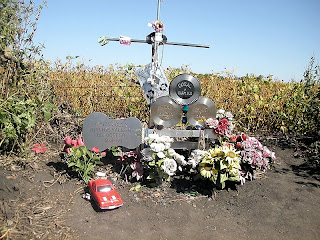… He died February 3, 1959 in a plane crash in Iowa.
Born Ricardo Esteban Valenzuela Reyes, in Pacoima, a neighborhood in the San Fernando Valley region of Los Angeles, Ritchie Valens was a rock and roll pioneer and a forefather of the Chicano rock movement. Valens' recording career lasted only eight months. During this time, however, he scored several hits, most notably "La Bamba a Mexican folk song that Valens transformed with a rock rhythm and beat that became a hit in 1958.
Raised hearing traditional Mexican mariachi music, as well as flamenco guitar, R&B and jump blues, Valenzuela wanted to create music of his own by the age of 5. He was encouraged by his father to take up guitar and trumpet, and later taught himself the drums.
One day, a neighbor came across Ritchie trying to play a guitar that had only two strings. He re-strung the instrument, and taught Ritchie the fingerings of some chords. Though left-handed, he was so eager to learn the guitar that he mastered the traditionally right-handed version of the instrument.
By the time he was attending Pacoima Junior High School, his proficiency on the guitar was such that he brought the instrument to school and would sing and play songs for his classmates.
When he was sixteen years old, he was invited to join a local band named The Silhouettes as a guitarist. When the lead vocalist left the group Ritchie became the main vocalist. On October 19, 1957, Ritchie Valenzuela made his performing debut with the group.
At his appearances, he often improvised new lyrics and added new riffs to popular songs while he was playing. This is an aspect of his music that is not heard in his commercial studio recordings. Due to his high-energy performances, Valenzuela earned the nickname "The Little Richard of the Valley."
In May 1958, Bob Keane, the owner and President of Del-Fi Records, a small Hollywood record label, was given a tip about a young performer from Pacoima. Keane went to see Valenzuela play a Saturday morning matinée at a movie theater in San Fernando. Impressed, he invited Ritchie to audition at his home where he had a small recording studio in his basement.
Keane decided to sign Ritchie to Del-Fi. Keane asked the young singer to shorten his surname to Valens from Valenzuela, in order to broaden his appeal.
Several songs that would later be re-recorded at Gold Star Studios in Hollywood were first demoed in Keane's studio. (These original demos can be heard on the Del-Fi album Ritchie Valens — The Lost Tapes.)
(Continued below video and Amazon portals ...)
(Press album cover for direct link to the entire Amazon Website):
-----
In addition to the demos, two of the tracks were taken to Gold Star and had additional instruments dubbed over to create full-band recordings. "Donna" was one track, and the other, an instrumental entitled "Ritchie's Blues."The first songs recorded at Gold Star one afternoon in July 1958, were "Come On, Let's Go," and "Framed."
Pressed and released within days of the recording, the record was a success. Valens' next record, a double A-side which was the final record to be released in his lifetime, had the songs "Donna" (written about a real girlfriend), coupled with "La Bamba."
In the autumn of 1958, Valens quit high school to concentrate on his career. Keane booked appearances at venues all across the United States and performances on television programs. Valens, however, had a fear of flying brought on by a freak accident at his Pacoima Junior High School when two airplanes collided over the playground, killing or injuring several of his friends. He eventually succeeded in overcoming his fear enough to travel by airplane.
In Los Angeles, Valens filmed an appearance in Alan Freed's movie Go Johnny Go between the live appearances, Ritchie returned to Gold Star several times, recording the tracks that would comprise his two albums.
In early 1959, Valens was traveling the Midwest on a multi-act rock and roll tour dubbed "The Winter Dance Party."
Accompanying him were Buddy Holly with a new back-up band, Tommy Allsup on guitar, Waylon Jennings on bass, and Carl Bunch on drums; Dion and the Belmonts; J.P. "The Big Bopper" Richardson; and Frankie Sardo.
After the February 2, 1959, performance in Clear Lake, Iowa, Holly, Richardson, and Valens flew out of the Mason City airport in a small plane that Holly had chartered. The plane, a four-passenger Beechcraft Bonanza, departed for Fargo, North Dakota, and crashed shortly after takeoff in a snow storm.
Valens was inducted into the Rock and Roll Hall of Fame in 2001.
In 1988, Ken Paquette, a Wisconsin fan of the 50s era, erected a stainless steel monument depicting a steel guitar and a set of three records bearing the names of each of the three performers. It is located on private farmland, approximately eight miles north of Clear Lake.
####





















